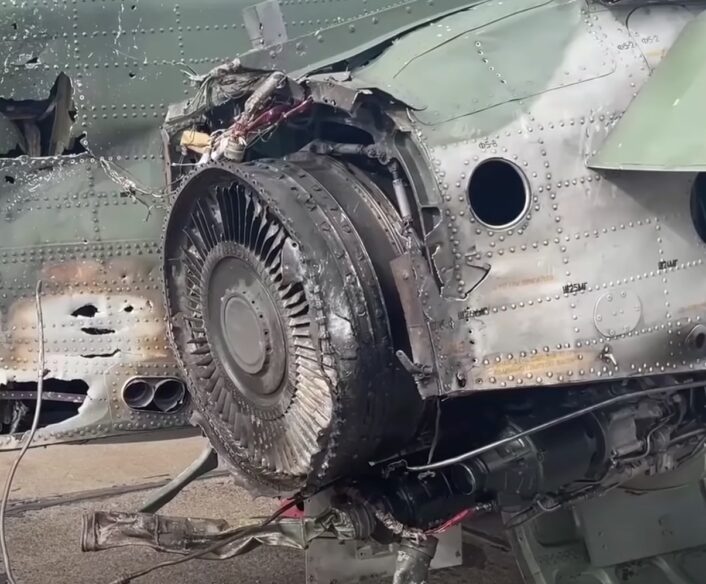The Russian Su-25 managed to land back at its airbase despite significant battle damage caused by a MANPADS hit.
Footage released by the Russian MOD early on Mar. 14, 2022, proves once again how sturdy the Sukhoi Su-25 Frogfoot can be. The clip shows the aircraft taxiing with significant damage reportedly caused by a MANPADS (Man Portable Air Defense System) that hit the jet on the rear right hand side of the fuselage.
Indeed, IR-homing missiles usually hit the engine nacelle/rear fuselage area where the temperature of the exhaust plume is higher and the Su-25 is not new to such events. There are plenty of photos and stories you can find online of Frogfoot aircraft that survived direct hits of 9K38 Igla, Stinger and other MANPADS during conflicts all around world. Anyway, today’s images are a reminder of both the impressive damage tolerance of the Su-25 and the threat posed to all Russian aircraft operating at medium and low altitude over the battlefields by the MANPADS operated by the Ukrainian forces.
Since the beginning of the Russian invasion, at least six Su-25s have been confirmed lost in Ukraine.
Dealing with the most recent event, the Russian MOD posted a video that shows the extent of the damage to the Su-25SM (that according to some sources was operating from an airfield in Belarus).
There’s also a brief account of the incident (that you can find roughly translated here below):
While performing a combat mission in the zone of a special military operation, the Su-25 attack aircraft, which is second in the pair, was hit by a missile from a man-portable air defense system fired from the ground by a serviceman of the armed forces of Ukraine. The pilot of the damaged aircraft, assessing the situation, decided to turn off the damaged engine and not leave the aircraft. The pilot of the leading (first) plane, Lieutenant Colonel Denis Litvinov, realizing that the comrade’s plane could not withstand a second missile hit, covered it with his own plane.
The pilot of the second aircraft visually detected the launch of the second missile and, firing off flares, managed to divert the missile to the side.
During the landing approach, the pilot of the damaged Su-25 reported an avionics and control systems failure, but managed to land thanks to the assitance provided by the pilot covering him. The landing was uneventful. Thanks to the cold-blooded and skillful actions of the pilot Denis Litvinov, he managed to save the life of his friend and the combat aircraft.
Both pilots are presented for state awards.
The Sukhoi Su-25 Grach (Russian for “Rook”), NATO reporting name Frogfoot, is a single-seat, twin-engine jet attack aircraft developed in the Soviet Union to provide CAS (Close Air Support) for the Soviet Ground Forces. The first prototype took to the air for the first time in February 1975. They were used in the Afghan and Ossetia theatres, in the Russia – Georgia conflict, back in 2008 as well as in Syria where they were first deployed in 2015.
Considered an equivalent to the U.S. A-10 Thunderbolt II CAS aircraft, the Soviet-design is smaller but more heavily armoured than its American counterpart, with as much as 1,100 kg of titanium armor compared to the 540 kg of the A-10. Nevertheless, in both types the pilots sit in a titanium aircraft armor, referred to as a “bathtub,” which protects the cockpit from rounds fired from below.
Both were designed and built with survivability in mind: almost everything in the jets is duplicated, so as to make them as durable as possible. In the A-10, there are two tails, two hydraulic systems, two engines which are positioned on the outer side of the fuselage so as to minimize the risk of fire in case one of the two turbofan engines is hit. In fact, just like the Russian Su-25, the “Warthog” is a pretty tough plane too, that has also shown its special ability to bring the pilot back in spite of heavy damages by ground fire.

H/T Lasse Holmstrom for the heads-up.









